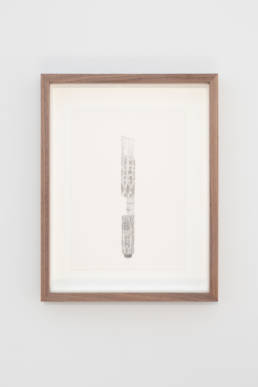Inward Investment
2014
Pencil on paper
I made Inward Investment after seeing a set of seventeen tutini (grave posts) at The Art Gallery of New South Wales in Sydney. The tutini were commissioned in 1958 by the philanthropist Stuart Scougall and the museum’s then deputy director Tony Tuckson, during a field trip to Yermalner in northern Australia. They were collectively produced by Tiwi artists Bob One Apuatimi (1925–1976), Don Burakmadjua (1925–1995), Charlie Quiet Kwangdini (b.1905), Laurie Nelson Mungatopi (b.1923), Jack Yarunga (1910–1973) and a sixth unnamed artist. Although objects made by Aboriginal and Torres Straight Islander people were being widely collected by European settlers and other Western individuals (from within and outwith Australia) by the 1950s, these tutini are the first examples of such objects being specifically commissioned for a public museum.
Traditionally, tutini form an important part of a Pukumani (burial ceremony), during which the deceased is buried with their possessions, and several specially made grave posts are erected in the vicinity. Although they look identical to those used ceremonially, the museum-commissioned tutini were made of ironwood rather than the customary blackwood. Following a Pukumani, blackwood tutini would be left at the gravesite to decay, along with the bodies they mark, and are thus encoded for Tiwi ceremonial purposes; whereas the harder ironwood versions in the museum will be preserved indefinitely and are thus encoded for European settler economic purposes.
The artists did not inform the commissioners of their intention to use a different wood, and although this is commonly read as evidence of a desire to reserve a particular material for a particular ceremony, it could equally be read as a form of institutional critique that anticipates Richard Bell’s seminal text, Bell’s Theorem: Aboriginal Art – It’s a White Thing! (2002). As well as very succinctly presenting a complex discussion of paternalism, exploitation and appropriation through a single gesture, the commissioned tutini also draw direct attention the Western art system’s desire to produce ever-lasting cultural assets. Inward Investment attempts to represent the transaction – with all its cultural and material tensions – between the museum and the artists by converting an image of the tutini to the medium of drawing. However much a drawing is protected, whenever it is exposed to light it will fade a little bit, meaning that all drawings have a viewable lifespan. Thus, whenever we look at one, we are watching it die.
Exhibited in:
Untitled
The Tetley, Leeds (24 Sept 2019 → 19 Jan 2020)





